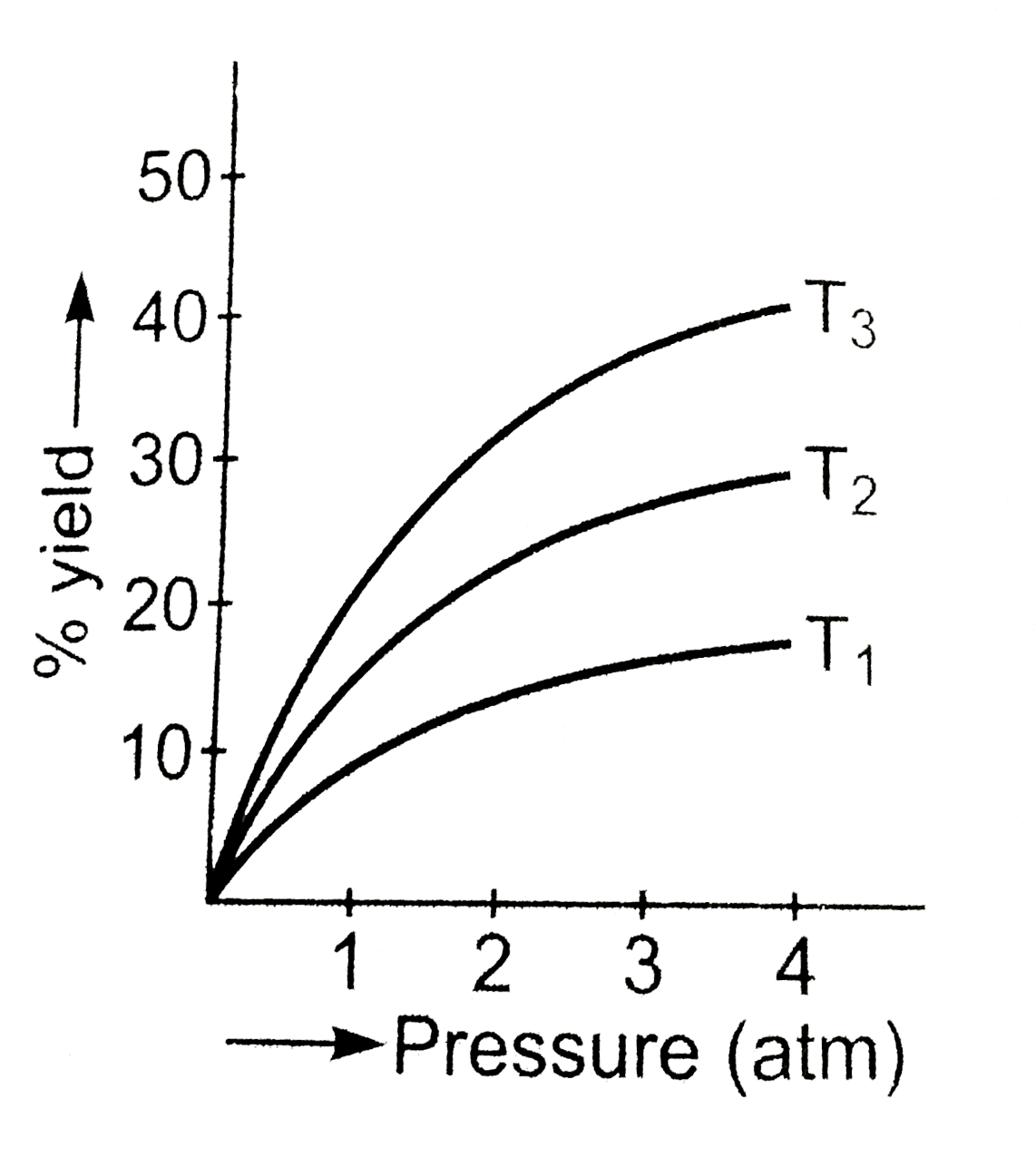The oxidation of SO2 by O2 to SO3 is an exothermic reaction. The yield of SO3 will be maximum if
temperature is increased and pressure is kept constant
temperature is reduced and pressure is increased
both temperature and pressure are increased
both temperature and pressure are reduced
The correct Answer is:B
To determine the conditions under which the yield of sulfur trioxide (SO₃) will be maximized in the exothermic reaction of sulfur dioxide (SO₂) with oxygen (O₂), we can follow these steps:
Step 1: Write the balanced chemical equation
The balanced equation for the reaction is:
2SO2(g)+O2(g)→2SO3(g)
Step 2: Identify the nature of the reaction
This reaction is exothermic, meaning it releases heat. In an exothermic reaction, the formation of products is favored at lower temperatures.
Step 3: Apply Le Chatelier's Principle
According to Le Chatelier's Principle, if a system at equilibrium is subjected to a change in temperature, pressure, or concentration, the system will adjust to counteract that change and restore a new equilibrium.
Step 4: Consider temperature
Since the reaction is exothermic, lowering the temperature will shift the equilibrium to the right, favoring the formation of SO₃. Therefore, a lower temperature will maximize the yield of SO₃.
Step 5: Consider pressure
In the balanced equation, we have 2 moles of SO₂ and 1 mole of O₂ on the reactant side (total 3 moles) and 2 moles of SO₃ on the product side. Increasing the pressure will favor the side with fewer moles of gas. Since there are fewer moles of gas on the product side (2 moles of SO₃), increasing the pressure will also shift the equilibrium to the right, favoring the formation of SO₃.
Conclusion
To maximize the yield of SO₃, the reaction should be conducted at:
- Low temperature (to favor the exothermic reaction)
- High pressure (to favor the side with fewer moles of gas)
Thus, the conditions for maximum yield of SO₃ are low temperature and high pressure.
The balanced equation for the reaction is:
2SO2(g)+O2(g)→2SO3(g)
This reaction is exothermic, meaning it releases heat. In an exothermic reaction, the formation of products is favored at lower temperatures.
According to Le Chatelier's Principle, if a system at equilibrium is subjected to a change in temperature, pressure, or concentration, the system will adjust to counteract that change and restore a new equilibrium.
Since the reaction is exothermic, lowering the temperature will shift the equilibrium to the right, favoring the formation of SO₃. Therefore, a lower temperature will maximize the yield of SO₃.
In the balanced equation, we have 2 moles of SO₂ and 1 mole of O₂ on the reactant side (total 3 moles) and 2 moles of SO₃ on the product side. Increasing the pressure will favor the side with fewer moles of gas. Since there are fewer moles of gas on the product side (2 moles of SO₃), increasing the pressure will also shift the equilibrium to the right, favoring the formation of SO₃.
To maximize the yield of SO₃, the reaction should be conducted at:
- Low temperature (to favor the exothermic reaction)
- High pressure (to favor the side with fewer moles of gas)
Topper's Solved these Questions
Similar Questions
SO3+H2O→ ______.
View SolutionAt 1300 k, and 1 atm pressure, A reaction was performed in 4 litre container as follows
2SO2+O2⇔2SO3
If Kc =40 and the mixture was supposed contain 2, 3 and 5 mole of SO2,O2 and SO3 respectively at any point of time of reaction. Then what will be the direction of the reaction ?View Solution
Knowledge Check
- Question 1 - Select One
The oxidation of SO2 by O2 to SO3 is an exothermic reaction. The yield of SO2 will be maximum if
Atemperature is increased and pressure is kept constantBtemperature is reduced and pressure is increasedCboth temperature and pressure are increasedDboth temperature and pressure are decreased. - Question 2 - Select One
The oxidation of SO2 by O2 to SO3 is an exothermic reaction . The yield of SO2 will be maximum if
Atemperature is increased and pressure is kept constantBtemperature is reducted and pressure is increasedCboth temperature and pressure is increasedDboth temperature and pressure are decreased. - Question 3 - Select One
The oxidation of SO2 to SO3 is an exothermic reaction. The yield of SO3 will be maximum if :
ATemperature is increased and pressure is kept constantBTemperature is reduced and pressure is increasedCBoth temperature and pressure are increasedDBoth temperature and pressure are reduced
The oxidation of SO2 by O2 to SO3 is an exothermic process. The yield of SO3 is maximum if
i. Temperature is increased and pressure is kept constant
ii. Temperature is reduced and pressure is kept constant
iii. Pressure is increased
iv. Temperature and pressure both are increased
The correct option is:View SolutionThe prepation of SO3(g) by reaction SO2(g)+12O2(g)⇔SO3(g) is an exothermic reaction .If the preparation follows the following temperature -pressure relationship for % yield , then for temperatures T1,T2andT3 the correct option is:
 View Solution
View SolutionThe reaction 2SO2+2O2⇔2SO3 will be favoured by
View SolutionThe formation of SO3 takes place according to the following reaction :
2SO2+O2⇔2SO3,δH=−45.2kcal
The formation of SO3 is favoured by :View SolutionThe formation of SO3 takes place according to the following reaction :
2SO2+O2⇔2SO3,δH=−45.2kcal
The formation of SO3 is favoured by :View Solution

